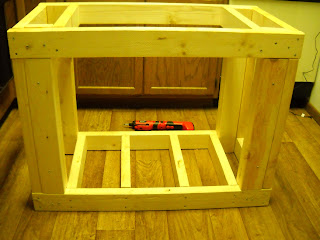I have decided to revamp my 40g breeder reef tank. This time I am going to do things right. I've made a lot of missteps in the past and I intend to correct them. First of all, I'm decided to step away from SPS (small polyp scleractinian) corals and focus solely on LPS (large polyp scleractinian) corals and chalice (
Echinopora) corals. The reason for this is I'm tried of spending hundreds of dollars on Acroporas and then having them die on my suddenly. LPS I know I can keep alive and chalices are low light so I would like to give them a try. The first step to my tank revamp is designing and building my sump. I've never had a sump before. I assumed they were unnecessary when I originally set up the 40, 6 months later, I see why everyone has one. I'm expecting this to make a huge difference to my tank. I have purchased an Eshopps PF-300 overflow kit and directional U-tube to plumb the tank and I found these designs online that will help me create my sump:

The sump will be made from a 20g long tank. I'm keeping my current skimmer which is a Coralife Super Skimmer 65. The return pump is a Marineland 1800 submersible pump. The first chamber is the skimmer section. Next is the bubble trap. The baffles are spaced 1.5" apart and the middle baffle is 1.5" off the floor of the tank. The middle section houses return pump and is 9" wide to allow enough volume to ensure the pump wont run dry. Finally there is a remote refugium that will filled separately and allow for a place to grow macroalgae and copepods as well as create a deep sand bed for nitrate removal and extra space for live rock. Here are some pictures from my actual build.
Planning stages. measuring out wall placement and checking that the tank is level before the install
First wall installed. The duct tape is to keep the wall up while the silicon was being used.
It turns out that 4 standard CD cases are exactly 1.5" and work really well for spacing out the baffles and provide something to listen to while building.
Two walls installed and enough room for the skimmer to operate.
My silicone skills are pretty sloppy. It's my first time so I'm not bothered as long as it holds water.
All three baffles that form the bubble trap are in place now. Still using CD cases to space out the walls.
Over head shot.
Refugium wall. Behind this will sit 6" of sand bed, live rock, and marcoalgae. This section will be lit opposite of the display tank to maintain pH stability.
All the walls are installed. Now I just to let them cure for 24 hours before I leak test the sump.




















